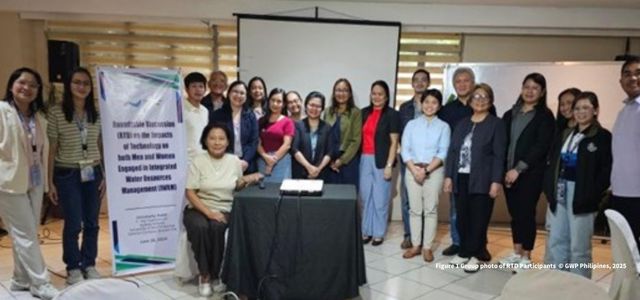Organized by the Philippines Water Partnership (PWP), the event brought together 24 participants from government agencies, NGOs, water service providers, and partner organizations. The discussion aimed to take a closer look at how technology, including state-of-the-art IWRM management tools and digital innovations, affects the professional and personal lives of both men and women working in the water sector.
Understanding the Dual Impacts of Technology
A study by the McKinsey Global Institute highlights how digital technology can accelerate gender equality across the Asia-Pacific by creating opportunities for women to earn income, achieve financial independence, and balance family responsibilities through flexible work arrangements. Access to digital platforms also enables women to pursue education, develop new skills, and aspire to leadership roles in various industries.
However, technology also presents risks. The RTD underscored that digital spaces can perpetuate gender biases and expose women to online harassment, bullying, and discrimination,issues that significantly impact well-being and safety. Participants agreed that the benefits and challenges of digital transformation are complex and context-dependent, requiring careful consideration to ensure women fully benefit from technological advances, including in the water and wastewater sectors, which remain largely male-dominated.
The RTD aimed to:
- Highlight and recognize the impacts of technology on both men and women in IWRM programs
- Understand the advantages and disadvantages of technological advancements for professionals in the sector
- Share personal and professional experiences on how technology affects daily work and home life
- Identify case studies and insights that can inform future gender-responsive approaches in IWRM
Expected outputs included a clearer understanding of gendered impacts, documentation of good practices, and identification of areas where technology can be leveraged to promote gender equity in water management.
Key Discussions and Insights
- Dr. Guillermo Q. Tabios III, Chairperson of PWP, opened the session by reflecting on the evolving role of women in science and technology. He observed that nations with more scientists tend to experience higher GDP growth and emphasized that interoperability and disruptive technologies are reshaping IWRM systems. He noted the encouraging rise of women entering science and engineering fields.
- Ms. Yolanda B. Gomez provided the rationale for the activity, highlighting how digital innovation, ranging from artificial intelligence to online platforms—has accelerated gender development and expanded career opportunities for women. Yet, she also cautioned that these same advancements expose women to new forms of online violence and inequality.
Two distinguished women leaders shared their experiences on how technology influences water resources management from different perspectives:
Engr. Susan P. Abaño, Chief of the Policy and Programs Division at the National Water Resources Board (NWRB), presented the government’s perspective. She showcased various digital tools used in regulatory work, such as telemetered water meters, groundwater monitoring systems, and online water permit applications.
Positive impacts: greater access to information, enhanced participation of women in decision-making, improved work-life balance, and opportunities for leadership.
Challenges: increased workload for training, potential burnout, and persistent fieldwork barriers for women.
Engr. Rodora N. Gamboa, President of Phil-CapNet, offered insights from the service provider perspective. She compared traditional and modern practices in source identification, treatment, and distribution, emphasizing how digitalization has enhanced efficiency, accuracy, and connectivity. However, she reminded that beyond adopting new technologies, it is crucial to empower people—especially women—to use them effectively. She advocated for applying a gender lens in technology design and implementation to ensure equitable access and use.
Towards Inclusive and Equitable Innovation
The discussion concluded that while technology has transformed how water resources are managed, its social impacts must not be overlooked. Ensuring inclusivity means not only developing innovative tools but also creating safe, empowering, and equitable digital environments for both men and women.
The insights and case studies from this RTD will contribute to ongoing national and regional dialogues on gender, technology, and water governance, reinforcing the importance of integrating gender perspectives in every stage of IWRM implementation.
